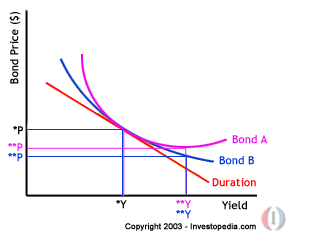Convexity
英文名称:Convexity 中文名称:凸曲度/凸性
衡量债券价格对利率变动敏感度的指标。在某一到期收益率下,到期收益率发生变动而引起的价格变动幅度的变动程度;从图形上看,凸性是对债券价格曲线弯曲程度的一种度量。债券价格曲线弯曲程度越大,凸性越大。
A measure of the curvature in the relationship between bond prices and bond yields that demonstrates how the duration of a bond changes as the interest rate changes. Convexity is used as a risk-management tool, and helps to measure and manage the amount of market risk to which a portfolio of bonds is exposed.
In the example above, Bond A has a higher convexity than Bond B, which means that all else being equal, Bond A will always have a higher price than Bond B as interest rates rise or fall.
As convexity increases, the systemic risk to which the portfolio is exposed increases. As convexity decreases, the exposure to market interest rates decreases and the bond portfolio can be considered hedged. In general, the higher the coupon rate, the lower the convexity (or market risk) of a bond. This is because market rates would have to increase greatly to surpass the coupon on the bond, meaning there is less risk to the investor.
附件列表
您所在的用户组无法下载或查看附件
词条内容仅供参考,如果您需要解决具体问题
(尤其在法律、医学等领域),建议您咨询相关领域专业人士。
如果您认为本词条还有待完善,请 编辑
上一篇 Convertibles 下一篇 Core Plus

